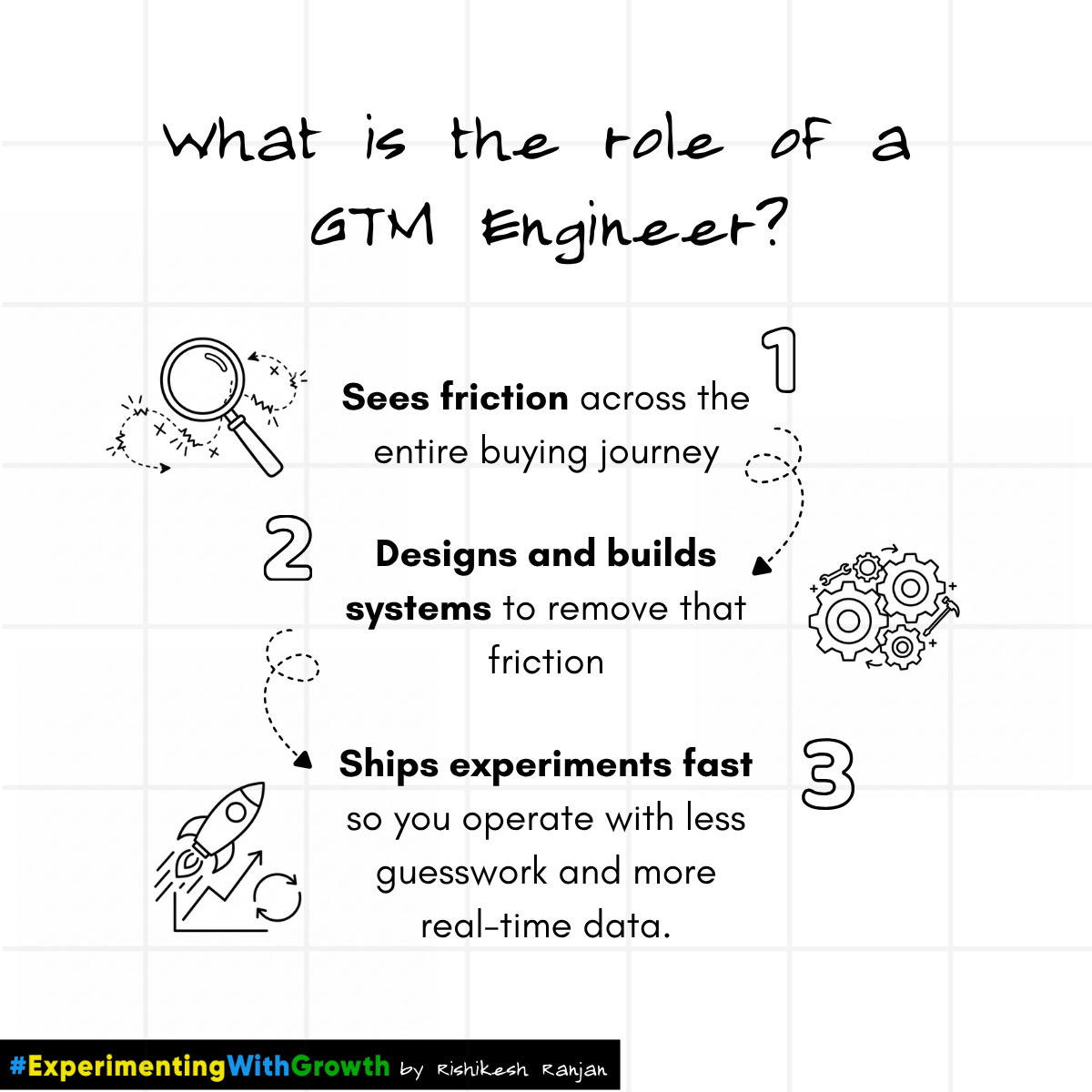For Founders: How a GTM Engineer Can Unblock Your Revenue Engine.
Introducing the hybrid role that combines engineering discipline with revenue obsession.
TL;DR
GTM Engineers are the critical link between your technical and non-technical teams. They remove friction across the entire GTM journey by building reliable data pipelines, creating lightweight apps and automations, which enable rapid experimentation.
They operate on a simple principle: prototype fast (using low/no-code where it helps) to find what works, then productionize the critical paths in robust code with proper monitoring and safeguards.
Measure them on outputs that enable outcomes (system uptime, data accuracy, speed of deployment). Hire for high agency, the innate drive to see their work translate into pipeline and revenue, even if they don’t carry a quota.
The Story of a Hidden Role
This article is the product of a long conversation with my friend, Anirudh.
We came from different worlds: I’m a CS grad who fell into the operational vortex of marketing automation, and he’s a pure engineer who kept getting pulled into sales and marketing workflows.
We discovered we were both doing the same un-defined, yet critical, job.
For a founder, the symptoms of not having this role are painfully familiar: sales complains that marketing leads are junk; marketing can’t prove their ROI; your CRM data is a mess; and a “simple” request to route high-intent leads to the right rep takes weeks and a dozen meetings.
What is a GTM Engineer? Your Engine’s Missing Part
Your GTM motion is a high-performance engine. Marketing provides the fuel, your sales team is the foot on the accelerator, and your product is the chassis. The GTM Engineer is the master mechanic and systems engineer who ensures the entire machine runs smoothly without any issues.
They are the person who sees the entire system and asks:
Are the data pipelines clean and delivering the right grade of qualified leads?
Are the analytics reports accurate, or are we flying blind?
Can we install a new automation or internal tool to get more performance out of the same engine? (What my CEO Lux calls getting more juice out of a channel)
A GTM Engineer is the sub-technical operator who:
Sees friction across the entire buying journey (from a lead’s first touchpoint to their expansion as a customer).
Designs and builds systems to remove that friction, whether it’s through data plumbing, clever automations, AI-assisted workflows, or simple internal tools.
Ships experiments fast, giving your sales and marketing teams the ability to operate with less guesswork and more real-time data.
Why Now? Four Trends Forcing This Role to Emerge
This role is a response to fundamental shifts in how companies grow.
Ops Went Full-Funnel: The customer journey is no longer a linear handoff from Marketing to Sales to Success. It’s a messy, looping path. GTM Ops now spans this entire journey, but the technical systems underpinning it are often disconnected. A GTM Engineer sits at these broken intersections.
Automation Got Democratized (and Messy): Tools like Relay.app and n8n are powerful, but they’ve allowed anyone to create complex workflows. This often results in “automation spaghetti”, a tangled, brittle web of workflows that no one understands and that breaks silently. This role brings engineering discipline to that chaos.
The Cloud Collapsed “Time to Internal Tool”: With platforms like Vercel and Fly.io, a single person can now spin up a useful internal app in an afternoon, not a quarter. The barrier to building and deploying internal apps has vanished, creating an opportunity for massive leverage.
AI Became a Practical Co-pilot: LLMs are incredible at summarizing sales calls, enriching leads, and scoring intent. But AI is only as good as the data it receives. A GTM Engineer ensures your data plumbing is sound, so your AI co-pilots are working with clean, structured, and timely information: not garbage.
The Core Functions: How a GTM Engineer Unblocks Revenue
So what does a GTM Engineer actually do day-to-day? Their work typically falls into four key areas:
1. Building a Foundation of Trustworthy Data
This is the single most important function. Without trusted data, everything else fails. A GTM Engineer makes events, accounts, contacts, and activities flow reliably between your core systems (Analytics, CRM, Marketing Automation, Data Warehouse, Billing).
They define data schemas, hunt down and eliminate duplicates, and build the foundational trust that allows your heads of sales and marketing to sit in a room and agree on a number.
2. Shipping GTM Experiments, Faster
They encode your GTM strategy into automated, measurable workflows. A GTM Engineer designs the systems for signal detection (e.g., a prospect visits the pricing page twice), automated enrichment (pulling company size from Apollo), intelligent routing (sending enterprise leads to senior AEs), and orchestrating outreach.
Crucially, they also build default paths, retries, and alerts for when things inevitably break.
3. Creating Force-Multipliers for Sales & Marketing
Instead of buying another off-the-shelf tool, a GTM Engineer can spin up small, internal apps that solve very specific problems. For example, a simple dashboard for AEs that shows their top 10 leads prioritized by product usage signals and recent marketing engagement, with AI-generated talking points for their next call.
These tools act as force-multipliers for your human teams.
4. Making Your Funnel Finally Make Sense
If it’s not measured, you can’t improve it. This role instruments everything: event tracking, cohort definitions, funnel math, and the velocity of feedback loops.
When your GTM motion is properly instrumented, arguments based on anecdotes (”I feel like these leads are bad”) are replaced by data-driven decisions (”Leads from this campaign have a 2% lower conversion rate, let’s investigate why”).
The Toolkit: When to Prototype vs. Productionize
The philosophy of a GTM Engineer is built on managing speed and risk. The goal is to learn as fast as possible without putting revenue-critical processes in jeopardy.
For Prototyping & Non-Critical Paths: Tools like n8n, Zapier, or Make are perfect. They are visual, fast, and great for testing a hypothesis. Want to see if enriching leads with GitHub data improves AE efficiency? Build a quick visual workflow and test it for a week.
For Production & Revenue-Critical Paths: Once an experiment proves its value, the brittle parts must be graduated to code (Python/FastAPI or Node/TS). Why? Because code offers version control, automated testing, structured error handling, and proper observability.
When a $100k deal depends on a lead being routed correctly, you don’t want it running on a workflow that could be accidentally changed by an intern.
How the Best GTM Engineers Think: Two Core Principles
Hiring for this role is more about mindset than it is about technical skills.
DRY with Judgment: “Don’t Repeat Yourself” is a core software engineering principle to avoid maintaining the same logic in multiple places. A GTM Engineer applies this realistically. They know when building a shared, reusable service is worth the effort, and when a little duplication is better than building the wrong abstraction. The goal is always clarity and ease of future change.
Delete → Simplify → Then Automate: This is the golden rule. Never automate a broken or unnecessarily complex process. A great GTM Engineer’s first instinct is not to build, but to question.
Can we eliminate this approval step? Can we simplify this 10-field form to 3 fields? They clean up the process before wiring up webhooks and queues, ensuring they aren’t just making a bad process run faster.
Measuring Success: Outputs that Drive Revenue Outcomes
How do you know if your GTM Engineer is doing a good job?
You don’t put them on a sales quota. Instead, you measure the outputs that enable your revenue teams to hit their outcomes. Think of it like a Formula 1 team: the race car driver (sales) is responsible for winning the race (outcome), while the engineering team is responsible for delivering a fast, reliable car (output).
Measure a GTM Engineer on:
System Reliability & Uptime: Are the core data syncs and automations working?
Data Accuracy: Do the commercial teams trust the numbers in the CRM and dashboards?
Deployment Speed: How quickly can the team launch a new experiment or workflow?
That said, the best GTM Engineers are high-agency. They don’t just ship the system and walk away. They constantly ask, “Did our pipeline actually move? If not, was the problem the data, the playbook, or the enrichment?” They influence outcomes even if they don’t own them.
Hiring Your First GTM Engineer: A Founder’s Guide
The Ideal Candidate Profile
You’re looking for a rare blend of technical depth and business acumen: a “T-shaped” individual.
The Depth (The ‘I’ of the T): They need to be technically (or technologically) good. This means a solid understanding of APIs (HTTP, auth, webhooks), data modeling, and observability.
They should have a preferred stack, like Python/FastAPI or Node/TypeScript, and be comfortable deploying and managing services.The Breadth (The ‘-’ of the T): They need to speak the language of the business. This includes understanding your Ideal Customer Profile (ICP), funnel math, the nuances of attribution, and most importantly, having empathy for the day-to-day reality of your sales and marketing teams.
A great question to probe this is: “What makes an Account Executive’s Thursday afternoon better?”
The Interview That Reveals True Ownership
Forget brain teasers. Give them a messy, real-world problem. Here’s an example you can copy:
“We just got a list of 300 leads from a trade show. Some work at companies that are currently hiring for roles we sell to. Some of their companies just pushed a new release on GitHub. A few of them visited our pricing page last week. Design a system to route the right leads to the right humans at the right time. Notify our AEs only when a lead has a strong enough signal, and explain your fallback for the rest.”
A great candidate will:
Whiteboard the entire system: events, states, retries, and fallbacks.
Discuss how they would instrument it to measure success and alert on failures.
Clearly articulate which parts they would prototype visually versus which parts they would immediately build in code.
Show an ownership reflex, saying things like, “And if pipeline doesn’t move after 2 weeks, here’s how I’d debug whether the issue was our attribution model, the sales playbook, or the enrichment data.”
Can’t Hire One? How to Grow a GTM Engineer Internally
If you can’t hire for this role externally, look within your own team. You likely have a highly analytical person in marketing ops or a business-savvy analyst who is itching for this kind of challenge.
Start them small: Give them a low-risk project, like prototyping a new lead enrichment flow using a visual tool.
Commit to code: Encourage them to graduate that workflow to code once it’s proven. Invest in their learning.
Build their portfolio: Have them build and document a series of “loops” → enrichment-to-outreach, churn-risk alerts, expansion triggers.
These documented wins are the foundation of their new role and signal their value to the rest of the company.
The Amplifier for Your GTM Team
Teams can’t value what they can’t see. A GTM Engineer makes the hidden, messy plumbing of your revenue engine visible, reliable, and efficient. They are the ultimate amplifier. They make your sales or marketing teams faster, smarter, and more effective.
They are the ones who turn “we think this campaign is working” into “we know it is, and here’s the data,” and turn “we’ll get back to you next quarter” into “give me two hours.” They are the missing part of your engine.




